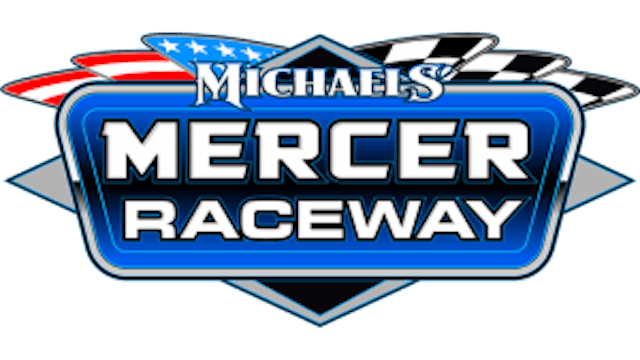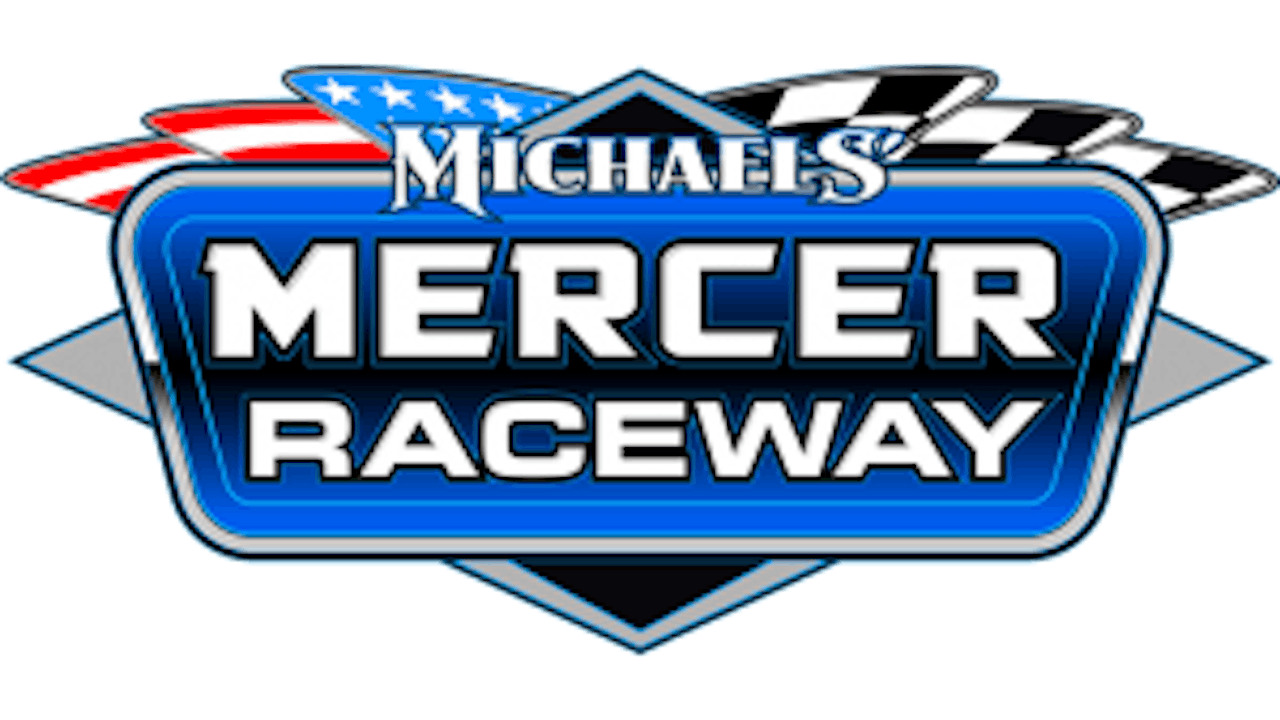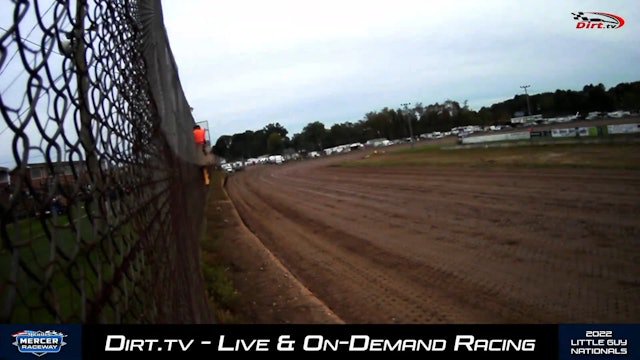Michaels Mercer Raceway
1 Episode
3/8-mile slightly banked clay oval located at the former Mercer County Fairgrounds that dates back into the 1800s. Track itself is considered to be one of the oldest in America. First official auto race held on July 26, 1951.
The early history of Mercer Raceway, up to 1963
Mercer Raceway Park celebrated its 50th year in operation on July 21, 2001. Fifty years to a younger person may seem like an eternity, while a senior citizen may look at that amount of time as “only yesterday”. To those who were in attendance that Thursday night more than 50 years ago, it does indeed seem like yesterday and to the younger folks, well they can’t even imagine what it might have been like back in the “old days”. I will attempt to document some of the memories and milestones of Mercer’s long and colorful history with the help of my friend Walt Wimer, long time race statistician, track announcer throughout the area and well-known writer for several tri-state racing publications over the years.
Currently under the ownership and guidance of Bill Altman, fans are enjoying the continuing revitalization of a state-of-the art racing facility that rivals any of its kind in the area. How it got to this point is our focus for this article and we hope you enjoy our look back.
The old covered grandstands
The track itself and three or four old maple trees are the last remnants of the original fairgrounds built in 1873-74 to house the Mercer Fair, an event that in it’s heyday drew up to 10,000 people a day back when the horsepower on the track came one at a time. The track was originally a half-mile in length and the tree line around the track and pit area still follows its original course.
Naturally, horse racing was the preferred activity from the 1870s till the 1940s. World War II seemed to bring about the beginning of the end for the fairs with the final fair around 1950. When the 50 odd acres went up for sale in early 1946, Lewis Persch, a Mercer businessman, purchased it. Persch, a fan of harness racing, as well as motorcycle racing, decided to try promoting those types of racing at his track. In order to run night races on the half-mile track, Persch purchased several dozen floodlights, which were originally used to illuminate the Army processing compound at Camp Reynolds in Transfer. Results of those early races are unknown but apparently they were of limited success. After only a few, they were discontinued. Persch now had a track, covered grandstands and no form of racing. The facility was leased from time to time to various circuses and fairs in the late 1940s.
from the 1950’s
By 1950, both midget racing and stock car racing had begun to build a huge following. With the increased popularity, local tracks were beginning to appear. Most notably among those of the day were Sharon Speedway’s half-mile track and the Canfield Fairgrounds. Both tracks were hosting weekly shows to packed houses and it was inevitable that some of Western Pennsylvania’s residents would venture to these tracks and become fans themselves.
As they say, timing is everything and as it eventually happened, Lew Persch was a Pennzoil dealer. One of his bigger customers was the Tennessee Gas Pipeline Co., which happened to be installing a transmission plant a few miles north of Mercer. They purchased oil and greases, etc. from Persch and on a visit to Persch’s business, a TGP employee from Louisiana made a comment about how there “was nothing to do on a Saturday night” in the Mercer area. Hearing of this comment, friends of Persch mentioned stock car racing’s rapid increase in popularity, and how the Ohio tracks were packing the house. These friends were already involved in area racing and included: Bud Bickel, John Bickel and Park McKee of the Grove City area and Al Metz, Sr. of Masury, Ohio. The Bickel’s already owned a car with Dick Bailey of Grove City as driver and had been running Sharon and various other tracks. The four men formed a partnership and convinced a skeptical Lew Persch to lease them the facility to promote stock car races. A deal was made with Persch to get 20 percent of the admission fees and a deal was made with the State Line Stock Car Racing Association to sanction the events.
1950’s photo
It was decided that the half-mile track would not be appropriate for auto racing so an arrangement was made with these same construction men from Tennessee Gas to bring in some of their equipment and build a smaller 3/8-mile track. This construction proceeded rapidly in the spring and early summer of 1951 and finally by July the track was ready to open. The new promoters wanted to race on Saturday nights but Canfield Speedway was already operating on Saturday. The decision was made to run on Thursday nights for the time being and finally on July 26, 1951, Mercer Raceway (now Park) opened to the public for the first time. Ed Bruce was the announcer that night and Art Holbrook dropped the very first green flag. Pit Steward was Al Terrace and the Timer was George Zipay. Records show that 1310 paid admission that night and 58 complimentary passes were given. The purse for the night of $540.50 was turned over to Bill Brei, the president of State Line Racing for disbursement to the drivers.
1950’s photo
Who were those drivers? Looking back through a partial roster of State Line members reveals the following: Gene Simpson, Glen Davis, Ken Feigert, Tony Banick, George Sember, John Sember, Chuck Garrett, Chuck Seaburn, Bill Burdette, Johnny Spadin, Bud Brautigan, Bob King, Ken Lewis, Jim Knapp, Ralph Rhoades, Bill Hite, Wink Hastings, Bill Ibbs, Don Winkelvoss, Steve Unger, Johnny Holfelder, Al Metz Jr., Tom Paxton, Emil Smolnik, Jack Buynak, Vince Burns, Ron Riddle, Tom Betts and Barney Barnes. On September 1, a midget race was held with 2270 fans attending and was such a success that they were back for a season finale on September 29.
1952 was to be the first full season of racing. Opening night was May 17; however, the night was incomplete due to rain. May 31 was the first full night of the ’52 season. 1244 were in attendance in the grandstand. The following week saw attendance jump to 2100 even. State Line’s 40% of the gate gave them a purse of $840.86 to run for. There was no guaranteed purse then, you were paid by your ability to draw a crowd to watch you race.
Steve Ungar and his bride are married — at the trackOne of the notable events during the 1952 season was the track marriage of Steve Unger and Patty Judge of Garrettsville, Ohio. At the time, Steve was one of the top drivers in the area and this much-publicized event drew quite a crowd. A collection was taken in the stands for the new couple and dollar bills were taped around the windows of Steve’s ’37 Chevrolet race car while he donned a suit for the marriage, which took place during intermission. Steve then changed back to racing clothes and went back out and ran the feature event. Although it caused a lot of grief back then, there is a rather humorous story about this event. While every detail had been attended to to make sure that the Unger wedding went off without a hitch and with dignity despite the circumstances, it turned out that one detail had been overlooked. It seems that the bride and groom were being married in Pennsylvania while they had inadvertently obtained an Ohio marriage license. This forced track officials to chauffeur them across the state line to an Ohio Justice of the Peace immediately after the races, to make their vows legal!
Park McKee presented a watch to Bud Brautigam after a 1954 feature win.The original four partners of Bud & John Bickel, Al Metz Sr. and Park McKee promoted through the end of the 1954 season. At that time they decided not to renew their lease and Don Godfrey of Mercer came aboard as promoter for the 1955 season. Godfrey made further improvements to the track, including an attempt to level the surface. The original track followed the general lay of the land: high in turns 1 and 2 and downhill to turns 3 and 4. When the track was originally cut in, it was not surveyed and to make matters worse there is a natural spring where turn 3 should actually have gone so the equipment operators had to adjust and cut the track in much more sharply than desired which left the track with an unusual “D” shape.
Bud and Jim Bickel Godfrey had fill brought in from Tennessee Gas again as they were installing transmission lines at the time and this fill was used to elevate the third and fourth turns in an attempt to bring the track up to level. This fill was unscreened sand and gravel and was covered over with a layer of clay. From that day forward Mercer became infamous for its stones that would appear out of nowhere. TNN announcer and sprint car Hall of Famer Brad Doty appeared at the track a short while back and I asked him what his most vivid memory of racing at Mercer was. Without hesitation he said “Oh, the rocks!” Fortunately, that problem has been eliminated over the last few years and those comments have disappeared.
Another improvement Godfrey made was the addition of a tire catch fence to protect the spectators. After fans were injured at another track on the Fourth of July, 1957, Don decided to add the catch fence. The story goes that it was one of the first of its kind in the country and now is mandatory throughout the sport. Among those drivers who were earning their rookie stripes between 1957 & 1959 were: Ralph Quarterson, Lou Blaney, Buddy Cochran, Conny Allen, Bill Banick & Lou Gentile to name just a few. Godfrey promoted the track through the end of the 1959 season and chose not to renew his lease for 1960. The track sat dormant through 1963.
Gary Martin Finally, after several spring rainouts, Mercer Raceway re-opened to a new era on June 6, 1964 featuring 3 divisions of racing. The new classes were: Super Modifieds, Super Hardtops and Stocks. Auto Racing Inc. was now sanctioning the races. Lew Perch’s son-in-law, Otis Coulter, was to be the new promoter and both he and Lew were very concerned that there would not be any fans in the Grandstand (which the Amish had just refurbished) after the track had been closed for four years. Their fears were unfounded as they opened to a packed house with the opening race delayed several minutes till all the fans could be seated.
-
Michaels Mercer Raceway Little Guy Nationals
Episode 1
2022 Little guy nationals
Fri-Sat Sept 30th Oct 1st
*Open small blocks $1500 to win
*Pro stocks (penn/Ohio rules) $1000 to win
*FASTRAK/602 crate sportsman mods (Fastrak/Raceway 7 rules) $900 to win
*Racesaver 305 sprints $600 to win
*UMP modifeds (emods) UMP modifed rules $1000 to win (Econom...



